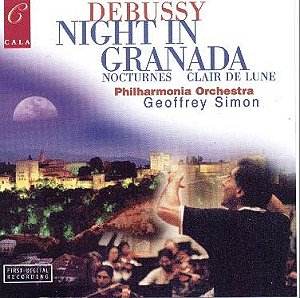Claude DEBUSSY (1862-1918)
Night in Granada (arr. Stokowski)
Clair de Lune (Caplet)
Pagodes (Percy Grainger)
The Girl With the Flaxen Hair (Gleichmann)
Nocturnes
Première Rhapsodie
Petite Suite (Büser)
 James Campbell (clarinet)
Women's Voices of the Philharmonia Chorus
James Campbell (clarinet)
Women's Voices of the Philharmonia Chorus
 Geoffrey Simon conducts The
Philharmonia Orchestra
Geoffrey Simon conducts The
Philharmonia Orchestra
CALA CACD1025 [66:49]
'Recorded at St. Jude-on-the-Hill, Hampstead, London: January
1990. High Resolution remastering February 2000 Recoupled and remastered
from the original Cala Records releases CACD1001 and
CACD1002'
Crotchet

I suggest that this review is read in conjunction with that of the Cala companion
Debussy album, Engulfed Cathedral which I am reviewing
this month too.
Many musicians have felt compelled to transcribe many of Debussy's highly
atmospheric and evocative piano pieces for orchestra. This album, together
with its companion disc 'The Engulfed Cathedral', is a fascinating collection
of some of these transcriptions.
In this set, the most interesting item has to be Percy Grainger's extraordinary
arrangement - for thirteen percussionists, four grand pianos, celesta, dulcitone
and a harmonium - of Debussy's Pagodes. Pagodes, the
first of the three Estampes of 1903, had been inspired by the sounds
of the Javanese gamelon orchestra that Debussy had heard at the Universal
Exhibition in Paris in 1889. Percy Grainger actually gave the first British
performance of Pagodes. His arresting transcription played her by
an ensemble that includes Piers Lane, John Lavender and Grainger champion
Penelope Thwaites, is extremely colourful and highly effective in its evocation.
Its complex intersecting ripples of bell and piano tones is hauntingly beautiful.
This is the world première recording of this transcription.
Stokowski's Night in Granada is a transcription of Debussy's
La Noche en Granada -the second Estampes of 1903 and Geoffrey
Simon and the Philharmonia fully realise all its langour and sensuality.
In contrast they are magically wistful in André Caplet's well-known
transcription of Clair de Lune and in William Gleichman's beautiful
arrangement of Debussy's La Fille aux cheveux de lin from his
First Book of Twelve Preludes for Piano (the same volume that contains The
Engulfed Cathedral). This "portrait of a maiden in diaphanous lines"
was originally inspired by a poem of Leconte de Lisle which commenced: "Who,
seated on the flowering lucerne, sings in the fresh morning air? It is the
girl with the flaxen hair, the beautiful girl with cherry lips."
Debussy's friend, Henri Büsser, orchestrated his four movement
Petit Suite (originally composed as a piano duet in 1889) in
1907. In Simon's hands it is thoroughly charming. It begins with a lazy summery
evocation, En bateau, and one can imagine that the occupants of the
boat were enjoying a dreamy romantic afternoon. The sprightly yet graceful
Cortège seems to have been inspired by a poem of Verlaine,
wherein a pet monkey in a brocaded jacket trots in front of his mistress
whilst she daintily flutters a delicate handkerchief. Menuet, coy
and wistful, is an old fashioned classical dance. The suite concludes with
Ballet reminding one of the works of other French masters of the genre
like Delibes and Saint-Saëns.
The concert is rounded off with performances of two of Debussy's own orchestral
works. Simon gives us a very good reading of the Nocturnes
but there are more interesting performances around. I would nominate Ansermet,
Solti and especially the recently released live recording by Celibidache
and the SWR Stuttgart Radio Orchestra.
Debussy's Première Rhapsody is less well-known and is
a real asset here. It was originally conceived for just clarinet and piano
but Debussy orchestrated it himself. This is a beautifully shaped performance
with James Campbell eloquently voicing all its languor and lyricism and then
its skittishness.
An important addition to the Debussy discography.
Ian Lace

